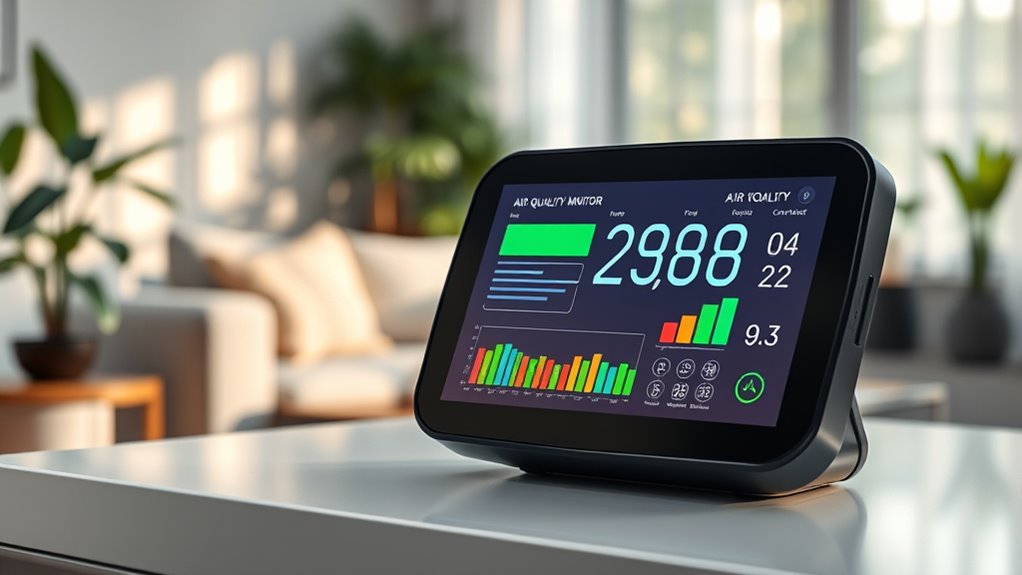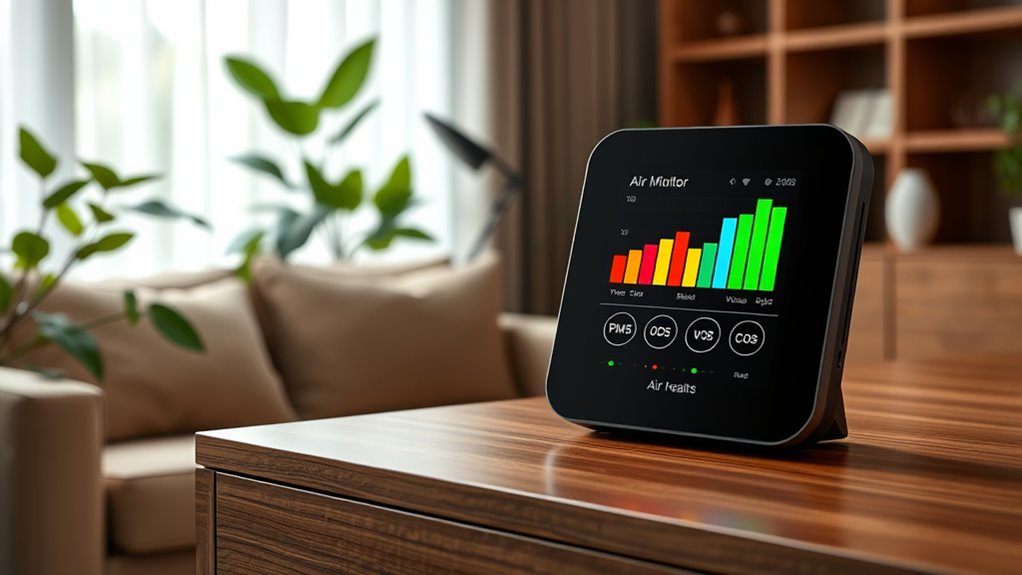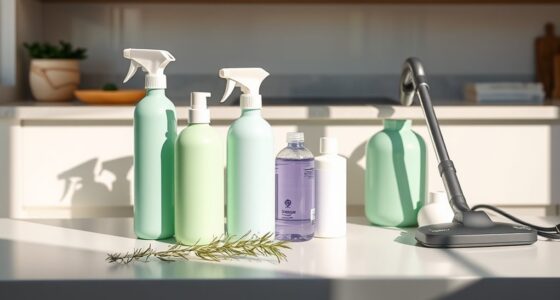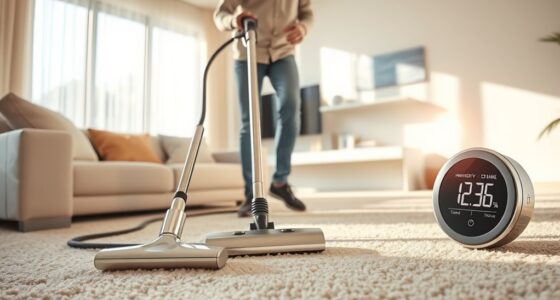Indoor air quality monitors help you track pollutant levels like particulate matter, VOCs, and CO₂, so you can create healthier indoor spaces. They provide real-time data, helping you identify poor ventilation or pollution sources. Proper handling, calibration, and understanding the connection between ventilation and sensor accuracy are key to getting reliable results. If you want to learn more about maintaining accurate readings and improving your indoor environment, keep exploring these essential tools.
Key Takeaways
- Indoor air quality monitors measure pollutants like particulate matter, VOCs, CO₂, and humidity to assess air safety.
- Elevated pollutant levels may indicate poor ventilation or sensor inaccuracies, requiring investigation.
- Proper calibration and maintenance of sensors ensure accurate readings for effective air quality management.
- Improving ventilation, such as opening windows or upgrading systems, helps lower pollutant concentrations.
- Interpreting monitor data helps identify issues promptly and supports proactive steps for healthier indoor environments.

Indoor air quality monitors are essential tools for guaranteeing a healthier living and working environment. They give you real-time insights into the levels of pollutants like particulate matter, volatile organic compounds, carbon dioxide, and humidity. But to truly rely on these devices, you need to understand how they gauge air quality and what factors influence their accuracy. One critical aspect is ventilation effectiveness, which directly impacts pollutant levels indoors. Proper ventilation helps dilute contaminants, bringing fresh air in and removing stale, polluted air. When your monitor indicates high pollutant readings, it could be a sign that your ventilation system isn’t functioning effectively or isn’t effectively exchanging indoor air with outdoor air. Monitoring ventilation effectiveness with your device can help you identify if you need to improve airflow, open windows, or upgrade your ventilation system to create a cleaner environment. Additionally, understanding cybersecurity vulnerabilities associated with smart monitors can help protect your data and device from potential threats.
Monitoring ventilation effectiveness helps maintain accurate indoor air quality readings and a healthier environment.
Another crucial factor in guaranteeing your air quality monitor provides accurate readings is sensor calibration. Over time, sensors can drift from their original settings, leading to inaccurate pollutant measurements. Regular calibration is essential to maintain precision, especially if your device is used continuously or in environments with fluctuating air quality. Many monitors come with automatic calibration features, but it’s wise to verify and manually calibrate your sensor periodically. This process often involves comparing your monitor’s readings with a known standard or reference device, then adjusting the sensor accordingly. Proper sensor calibration ensures that the data you rely on reflects true pollutant levels, enabling you to make informed decisions about your indoor environment.
Understanding the importance of ventilation effectiveness and sensor calibration helps you better interpret your indoor air quality readings. When a monitor shows elevated levels of pollutants, it could be due to inadequate ventilation or sensor inaccuracies. By regularly evaluating and improving ventilation, you can reduce pollutant concentrations naturally, making your space healthier. Simultaneously, maintaining your sensors through calibration guarantees that the readings are trustworthy. This combination allows you to respond promptly to air quality issues, whether that means increasing airflow, addressing indoor sources of pollution, or scheduling professional calibration checks.
Ultimately, the key to using indoor air quality monitors effectively lies in understanding the interplay between ventilation and sensor accuracy. These devices are powerful tools, but their effectiveness depends on proper setup, regular maintenance, and your ability to interpret the data correctly. When you stay proactive in managing ventilation effectiveness and sensor calibration, you create a safer, healthier environment for yourself and those around you. Good air quality isn’t just about having the right monitor — it’s about understanding how to keep your indoor air clean and ensuring your device provides reliable information.
Frequently Asked Questions
How Often Should I Calibrate My Air Quality Monitor?
You should calibrate your air quality monitor every 3 to 6 months to guarantee peak sensor accuracy. Regular calibration helps maintain reliable pollutant readings and prevents drift over time. If you notice inconsistent or unexpected measurements, consider calibrating sooner. Follow your device’s manufacturer instructions for calibration procedures, and use proper calibration gases or standards. Consistent calibration guarantees that your monitor provides precise data for a healthier indoor environment.
Can Indoor Air Quality Monitors Detect All Types of Pollutants?
Indoor air quality monitors can’t detect all types of pollutants due to monitor limitations. They are effective at identifying common pollutants like VOCs, particulate matter, and carbon dioxide, but may miss others like radon or certain gases. You should be aware that each monitor has specific capabilities, so understanding its pollutant detection limits helps guarantee you’re accurately monitoring your indoor environment. For thorough safety, consider using specialized tools for certain pollutants.
What Is the Ideal Placement for an Air Quality Monitor?
You should place your air quality monitor at sensor placement that reflects your breathing zone, typically around 3 to 6 feet above the floor. Keep it away from walls, vents, and windows to avoid skewed pollutant detection. Position it centrally in the room, avoiding direct sunlight or sources of pollution, so it accurately measures the indoor air quality and helps you identify and address pollutant levels effectively.
Do Air Quality Monitors Require Wi-Fi Connectivity?
Think of Wi-Fi dependence as a lifeline for your air quality monitor; it needs connectivity requirements to send data. Many models do require Wi-Fi to provide real-time updates and remote access, but some work offline or with Bluetooth. If you want continuous monitoring and easy control from anywhere, choose a monitor with Wi-Fi. Otherwise, select one that suits your needs without relying on constant internet connection.
How Long Do Indoor Air Quality Monitors Typically Last?
You can expect your indoor air quality monitor to last around 2 to 5 years, depending on the device and usage. Regular sensor maintenance helps extend its lifespan, ensuring accurate readings. Keep in mind that some monitors have replaceable sensors, which can prolong the device’s usability. To maximize your monitor’s longevity, follow manufacturer guidelines for cleaning and calibration, and replace sensors when necessary to maintain peak performance.
Conclusion
By paying attention to indoor air quality monitors, you gently navigate the subtle nuances of your home’s atmosphere. While unseen, these devices whisper insights that help you foster a healthier environment. Embracing their guidance allows you to refine your space, creating a sanctuary where comfort and well-being quietly flourish. Remember, a little awareness can softly transform your daily experience, turning the delicate balance of air into a subtle, ongoing act of care.









